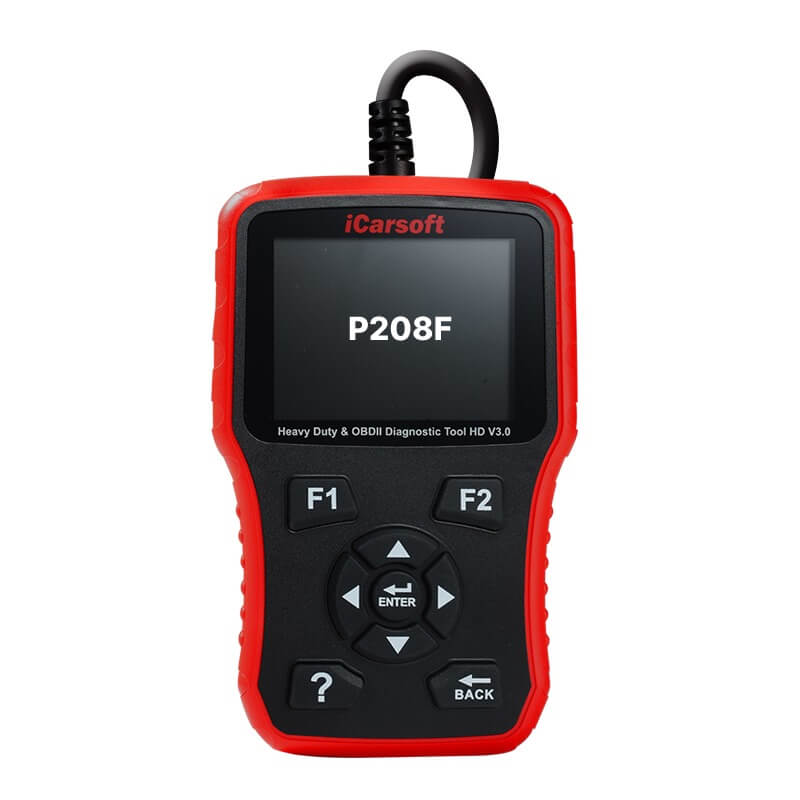P208F – Reductant Pressure Too High
POSTED IN pcodes
When it comes to maintaining proper emission control in your vehicle’s exhaust system, addressing issues promptly is essential. One fault code that you may come across is P208F, which indicates reductant pressure that is too high. This high pressure fault is related to the NOx reduction system and can have implications for the overall performance of your diesel emission reduction system.
The P208F fault code can be triggered by various factors, including a faulty reductant injector, problems with the SCR system, or issues with the catalyst performance. To diagnose and repair the underlying cause, it is crucial to take the necessary steps to avoid further damage to your engine and emission system.
In this article, we will explore the symptoms, common causes, troubleshooting steps, and repair options for the P208F – Reductant Pressure Too High fault code. By understanding these aspects, you will be better equipped to address the issue and maintain optimal engine performance and emissions control.
Key Takeaways:
- P208F fault code indicates reductant pressure that is too high in the NOx reduction system.
- Symptoms may include decreased fuel efficiency, rough engine performance, and black smoke from the tailpipe.
- Faulty reductant injectors, issues with the SCR system, and catalyst performance problems are common causes of P208F.
- Troubleshooting steps involve inspecting wiring connections, SCR system components, and catalyst performance.
- Repair options may include replacing the reductant injector, addressing faults in the control module, or uploading ECU files.
Symptoms of P208F – Reductant Pressure Too High
When your vehicle displays the P208F fault code, it indicates a reductant pressure that is too high. This fault code is related to the exhaust system and can have implications for emission control. Recognizing the symptoms can help you identify the issue and seek prompt repairs.
- Decreased fuel efficiency: One of the common symptoms of the P208F fault code is a noticeable decrease in fuel efficiency. If you find that your vehicle is consuming more fuel than usual, it could be a result of the reductant pressure issue.
- Rough engine performance: Another symptom to watch out for is a rough engine performance. You may experience engine misfires or a lack of smooth acceleration, indicating problems with the reductant pressure.
- Black smoke from the tailpipe: If you observe the emission of black smoke from the tailpipe, this could be a clear sign of high-pressure faults in the exhaust system. Black smoke indicates incomplete combustion and can be attributed to the reductant pressure issue.
If you notice any of these symptoms in your vehicle, it is recommended to have it inspected by a professional mechanic. They will be able to determine the exact cause of the fault code and carry out the necessary repairs to restore proper function to your exhaust system and ensure effective emission control.
Buy tested tuning file for Adblue / EGR / DPF / Adblue off now!

Example Quote
“It is important not to ignore the symptoms associated with the P208F fault code. Prompt diagnosis and repair can prevent further damage to your vehicle’s engine and ensure compliance with emission control regulations.”
| Symptoms of P208F – Reductant Pressure Too High |
|---|
| Decreased fuel efficiency |
| Rough engine performance |
| Black smoke from the tailpipe |
Common Causes of P208F – Reductant Pressure Too High
The P208F fault code can be triggered by several common causes that affect the reductant pressure and the NOx reduction system. Identifying these causes is crucial in the diagnostic process and subsequent repairs.
- Faulty Reductant Injector: A malfunctioning reductant injector can lead to an imbalance in the reductant pressure, resulting in the P208F fault code.
- Issues with the SCR System: Problems with the SCR system, such as a faulty dosing unit or blockages in the urea supply line, can cause high reductant pressure.
- Problems with Catalyst Performance: If the catalyst is deteriorated or damaged, it can affect the overall efficiency of the reductant system and result in increased pressure.
- Wiring and Connector Issues: Faulty wiring or connector problems can disrupt the communication between various components of the NOx reduction system, leading to abnormal reductant pressure.
- Faults in the Reductant Control Module: Errors in the reductant control module can cause incorrect reductant pressure readings and trigger the fault code.
- PCM Failures: Issues with the Powertrain Control Module (PCM) can also contribute to irregular reductant pressure, leading to the P208F fault code.
In order to determine the specific cause of the P208F fault code, a thorough diagnostic process should be carried out. This can include inspecting the reductant injector, evaluating the SCR system, examining the catalyst performance, and checking the wiring and connectors. By identifying the underlying cause, appropriate repairs can be made to rectify the high reductant pressure fault and restore optimal functioning of the NOx reduction system.
Troubleshooting Steps for P208F – Reductant Pressure Too High
When encountering the P208F fault code, indicating reductant pressure that is too high, it is crucial to follow proper troubleshooting steps to diagnose and address the issue effectively. By following these steps, you can identify the root cause and take appropriate measures to restore optimal emission control and prevent further damage to the SCR system.
Step 1: Check Wiring and Connections
Start by inspecting the wiring and connections between the reductant control module and the DEF injector, as well as the wiring to the NOx sensors. Look for any loose, damaged, or disconnected wires or faulty connections. Repair or replace any affected components as necessary.
Step 2: Perform SCR System Inspection
Thoroughly examine the SCR system for any signs of damage, leaks, or malfunctioning components. Pay close attention to the reductant pump, reductant injector, and SCR catalyst. If you notice any abnormalities, consult the manufacturer’s documentation or seek professional assistance to determine the appropriate repair or replacement procedures.
Step 3: Verify Catalyst Performance
Inspect the catalyst performance to ensure it is functioning optimally. A malfunctioning catalyst can contribute to high reductant pressure. Check for any physical damage, deterioration, or contamination that could affect its performance. If necessary, consult with a professional mechanic to perform additional tests, such as catalyst efficiency monitoring, to assess its functionality accurately.
Step 4: Seek Professional Assistance
If you have completed the troubleshooting steps mentioned above and are still unable to resolve the P208F fault code, it is recommended to consult with a professional mechanic or dealership familiar with your vehicle’s make and model. They will have the necessary expertise and diagnostic tools to identify the root cause of the fault code and perform any required repairs or replacements.
Remember, timely troubleshooting and corrective actions will not only prevent further damage to your vehicle’s emission control system but also ensure compliance with environmental regulations. Follow these steps diligently to address the P208F fault code and maintain optimal performance and efficiency.
Repair Options for P208F – Reductant Pressure Too High
When dealing with the P208F fault code, it is crucial to address the underlying cause promptly to ensure effective repairs. The specific repair options will depend on the identified issue causing the reductant pressure to be too high. Here are some potential repair options to consider:
- Replacing the Reductant Injector: A faulty reductant injector can cause high reductant pressure. If this component is determined to be the cause, it will need to be replaced with a new one.
- Repairing or Replacing SCR System Components: Issues with the SCR system can also lead to high reductant pressure. Conducting repairs or replacements on damaged or malfunctioning SCR system components may be necessary.
- Addressing Faults in the Reductant Control Module or PCM: The reductant control module or Powertrain Control Module (PCM) may be responsible for the high pressure fault. If faults are detected in these modules, they should be addressed accordingly.
In some cases, it may be necessary to upload the Engine Control Unit (ECU) file to a professional portal for further analysis. This allows experts to assess the data from the ECU and potentially find a permanent solution for removing the fault code.
It is important to consult with a qualified mechanic or technician to accurately diagnose the cause of the high reductant pressure and determine the most appropriate repair options. This will help ensure a comprehensive fix and restore the proper functioning of the emission control system.

| Common Repair Options | Pros | Cons |
|---|---|---|
| Replacing the Reductant Injector | – Fixes the specific component causing the fault code – Restores proper reductant pressure – Potential improvement in emission control |
– Cost of the new injector – Professional installation required |
| Repairing or Replacing SCR System Components | – Addresses issues with the SCR system – Improves overall system performance – Ensures compliance with emissions regulations |
– Cost of repairs or replacements – Potential need for professional expertise |
| Addressing Faults in the Reductant Control Module or PCM | – Resolves faults in integral control modules – Restores proper communication and functionality – Potential improvement in reductant pressure |
– Cost of repairs or replacements – Requires professional diagnosis and expertise |
| Uploading ECU File for Analysis | – Provides data for in-depth analysis – Potential permanent removal of fault code – Allows for tailored solutions |
– Requires access to professional portal – Relies on expert analysis and recommendations |
Conclusion
The P208F fault code, indicating reductant pressure that is too high, can have significant implications for your vehicle’s exhaust system and emission control. Understanding the symptoms, common causes, and troubleshooting steps can empower you to effectively diagnose and repair the underlying issues, ensuring optimal engine performance, reduced emissions, and compliance with emissions regulations.
Prompt attention to addressing the fault code is crucial. By promptly investigating and resolving the reductant pressure fault, you can prevent further damage to the engine and emission system. This proactive approach will not only save you from costly repairs down the line but also contribute to a cleaner environment by controlling NOx emissions.
Remember to consult with a professional mechanic if you lack the necessary expertise or equipment for troubleshooting and repair. They can accurately identify and address the specific cause of the high reductant pressure fault, whether it’s a faulty reductant injector, issues with the SCR system, or problems with catalyst performance. Trusting a professional will ensure that the repair is done correctly and effectively.
Maintaining the health of your vehicle’s reductant system is vital for overall performance and environmental impact. By taking proactive steps to address the P208F fault code, you can ensure that your vehicle operates efficiently while reducing harmful emissions. Stay informed, take action, and enjoy the benefits of a well-maintained NOx reduction system.
FAQ
What does the P208F fault code mean?
The P208F fault code indicates that the reductant pressure is too high in the NOx reduction system, which is responsible for controlling emissions.
What are the symptoms of the P208F fault code?
Some common symptoms include decreased fuel efficiency, rough engine performance, and the emission of black smoke from the tailpipe.
What are the common causes of the P208F fault code?
The P208F fault code can be caused by a faulty reductant injector, issues with the SCR system, problems with catalyst performance, wiring and connector issues, faults in the reductant control module, or PCM failures.
What are the troubleshooting steps for the P208F fault code?
Start by checking the wiring and connections, inspect the SCR system for damage or malfunctions, and verify the proper functioning of the catalyst performance. Consult with a professional mechanic for further diagnostic tests and repairs if necessary.
What are the repair options for the P208F fault code?
Depending on the specific issue, repairs may involve replacing the reductant injector, addressing issues with the SCR system components, or addressing faults in the reductant control module or PCM. In some cases, uploading the Engine Control Unit (ECU) file to a professional portal may be necessary for further analysis and potential permanent removal of the fault code.


